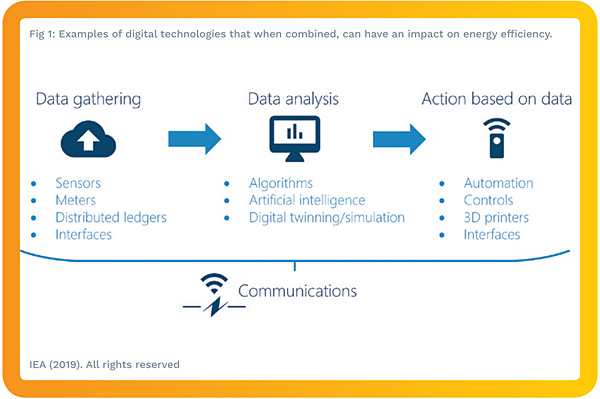 From binge-watching television series, to locating and renting a car through a smart phone, our lives increasingly rely on digital technologies. Digitalisation – the growing interaction and convergence between the digital and physical worlds – is an inevitable process, driven by increasing volumes of data, advances in our ability to analyse that data, and greater connectivity.
From binge-watching television series, to locating and renting a car through a smart phone, our lives increasingly rely on digital technologies. Digitalisation – the growing interaction and convergence between the digital and physical worlds – is an inevitable process, driven by increasing volumes of data, advances in our ability to analyse that data, and greater connectivity.
The energy sector is no different, with digitalisation changing both the way energy is supplied and consumed, as the IEA reported in Digitalization and Energy.
The growing impact of digital technologies on energy demand has been widely publicised: From estimates that streaming a film online consumes the same amount of energy as making 60 cups of tea, to others suggesting Bitcoin’s daily electricity consumption rivals that of a medium-sized country.
However, much less has been said about digital technologies’ potential to improve energy efficiency and potentially reduce energy use.
How can digitalisation improve energy efficiency?
Underpinned by the rollout of high-speed communications networks, the digitalisation of our homes, businesses and transport systems offers the potential to increase energy efficiency through a combination of technologies that perform three essential tasks:
- 1. Gathering data. This includes technologies such as smart meters, which gather high-resolution energy consumption data from homes and businesses, as well as technologies that collect a range of data related to energy use, such as sensors that record light levels, temperature, or location (e.g. GPS tracking).
- 2. Analysing data. Powerful computers, combined with increasingly ‘intelligent’ software algorithms, allow for the processing and analysis of data to produce insights into how energy can be used more efficiently. Examples include building information models in commercial buildings, ‘digital twins’ of industrial plants, and the on-board computer in a car.
- 3. Changing the physical environment based on data analysis. Increasingly, our connected devices and equipment are enabled with technologies that can optimise energy use instantly, based on digital signals. In buildings, connected devices such as lighting systems, heating and air-conditioning equipment, and water heaters can be programmed to optimise energy use, depending on the time of day and occupancy levels. In industrial facilities, smart actuators and drives can be controlled via advanced industrial energy management systems to make subtle changes to optimise energy use while increasing safety and reducing production costs.
A modern office building (or 'smart office') provides a good example of how digital technologies can combine to boost energy efficiency. Increasingly, offices are equipped with intelligent building energy management systems (i-BEMS), which collect data from sensors throughout the building: from light sensors, to thermostats, and occupancy sensors. These data are combined with other data from the electricity grid (collected via a smart meter), as well as data on factors such as weather conditions (gathered from the cloud). Artificial intelligence algorithms process the data, and these algorithms 'learn' over time to optimise energy efficiency, while also considering comfort and potentially responding to signals from local grid operators.
As individual devices in the office are fitted with their own sensors and smart switches, the i-BEMS can tailor energy consumption to the precise needs of the workers within a specific zone of the office, and switch devices off automatically when offices are unoccupied. The i-BEMS also allows for two-way communication with the grid, providing flexible load that can be sold to the grid operator, creating an additional revenue stream for the building manager and helping to increase the penetration of variable renewables into the electricity system.
The impacts of such systems can be significant, with some commercial buildings reporting energy cost savings and revenue generation equivalent to more than 10% of annual on-site energy costs and GHG emissions reductions of up to 40% thanks to load shifting and energy efficiency improvements.

Digitalisation can improve both end-use and system efficiency
The example of the smart office shows the power of digital technologies to improve the efficiency of energy end-uses like lighting, heating and cooling, and water heating, but also to unlock distributed sources of flexible load, generation and storage.
As a result, digital technologies can increase the efficiency of the entire energy system by reducing the need for expensive energy-intensive sources of power to cater for peaks in demand, reducing energy transmission and distribution losses, and helping bring more renewables into the generation mix.
By joining up end-use energy efficiency with distributed flexible load, generation and storage, digitalisation is helping to redefine the term ‘energy efficiency’ to encompass both end-use and system efficiency.
The IEA’s work on digitalisation and energy efficiency
The IEA has launched a cross-agency initiative to explore the potential impacts of digitalisation on energy efficiency and implications for policy makers. We are looking at how digital technologies enable greater control, optimisation and analytics, and how this in turn enables greater end-use and system efficiency, especially when combined with the right policy frameworks and innovative business models.
In June, we launched a digitalisation resource library at www.iea.org/efficiency and in late October, we will publish our flagship tracker of energy efficiency trends, Energy Efficiency 2019. This year's report contains a range of digital technology case studies and a set of policy principles for energy policy makers that want to increase the use of digital technologies for energy efficiency.
As digitalisation transforms energy efficiency and the broader energy system, the IEA will continue to support energy policy makers around the world to harness its benefits.